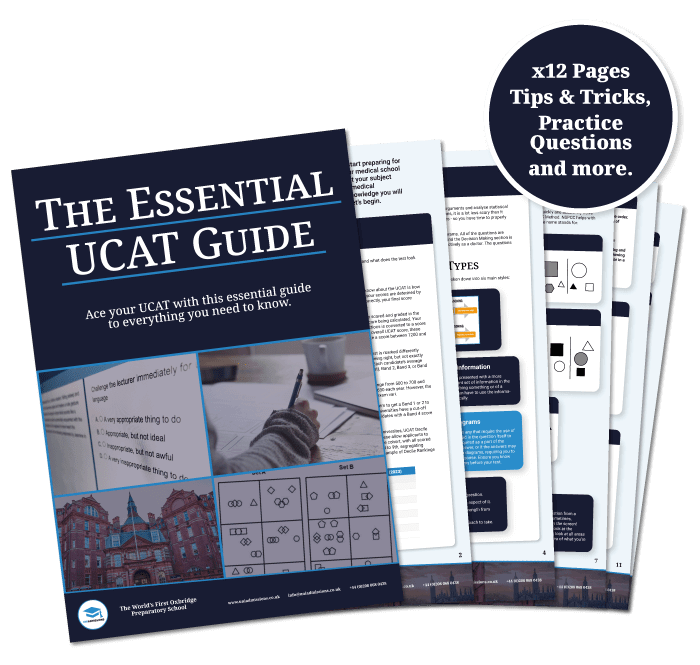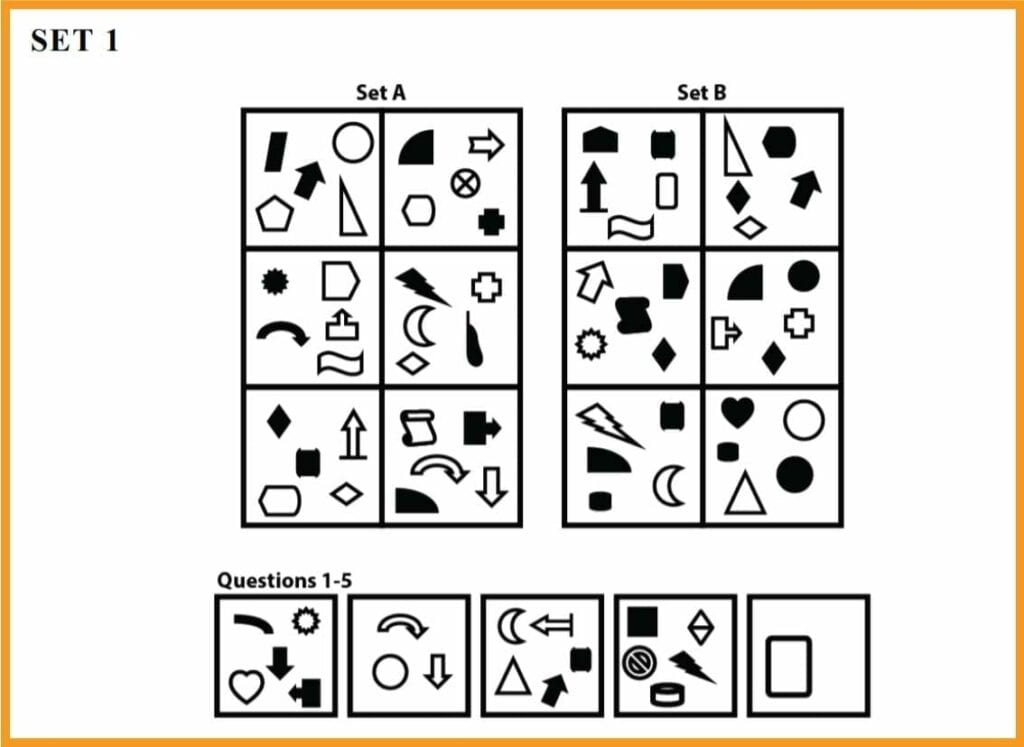UCAT CHANGES 2025
The Abstract Reasoning subtest will be removed from the UCAT in 2025. This will impact the timings and question totals of most other subtests. Be aware that the information in this guide is no longer relevant to UCAT test takers, and you should prepare for the Abstract Reasoning subtest.
The UCAT Abstract Reasoning section can be a very difficult one and is extremely different from other parts of the exam.
You may wonder why Abstract Reasoning is even included on the test, as it seems so far removed from any other section and with no clear link to the skills required for medicine. However, the idea of this section is test applicants on a variety of skills, including logical thinking and pattern recognition, two essential skills for doctors.
You will have to answer 50 questions in the span of just 12 minutes, so you will have to move fast as you will have under 15 seconds to read the instructions and answer the question.
This subtest is one out of the five sections in the UCAT. The other four are:
This guide will explain how these questions are structured and what method you can use to get the correct answer quickly and effectively. Let’s get started.
Why is Abstract Reasoning included?
The idea behind UCAT Abstract Reasoning is to test how well the candidate is able to respond to questions that may go beyond the scope of their knowledge or require them to apply their existing knowledge in an unusual way. This is thought to be helpful in determining how well a student will be able to interpret information such as scans, X-rays or other test results as a clinician.
With the way the section is structured, there are multiple questions per image set. Since the main investment in time is in figuring out the pattern, you have a greater proportion of the time to spend on the first question in each set. As a general rule of thumb, if there are 5 questions, you have around 60 seconds to complete the set.
This is what a typical question looks like so you know what we’re talking about (bear in mind that some written instructions will also be provided):
You may not have experience in Abstract Reasoning questions, so get some support for the whole UCAT with UniAdmissions.
Our comprehensive UCAT Programme gives you expert support through many different avenues of learning, such as one-to-one tuition, comprehensive preparation materials and intensive courses.
Discover how you can triple your chances of success now by booking a Free Consultation Session.
What types of Abstract Reasoning Questions are there?
Abstract Reasoning questions in the UCAT can be categorised into four separate question styles:
1. You are provided with two sets of six shapes, Set A and Set B.
All of the images within each set are linked to each other by a common rule, but the rule must be different for Set A and Set B. The task is to identify the rules for each set, then for the 5 options you need to decide where they belong.
2. You are provided with a single sequence of four shapes.
They should be read as a sequence from left to right. You are then asked to choose the next shape in the sequence out of four options. This style of question is normally quicker to answer as it is more intuitive.
3. You are provided with two shapes with a rule linking them.
The rubric states shape one is to shape two by this rule. Then you are provided with shape three, and you have to apply this rule to find out how the rule transforms shape three into shape four (you are given four options). Once again, the key to accuracy is in deducing the rule that links the shapes.
4. You are provided with two sets of six shapes, Set A and Set B, each linked by a common rule.
Once again apply the same system to deduce the rule for each set. The only difference comes when it is time to select your answer. Instead of being asked which set a shape fits into, you are provided with four options and asked to select the one that fits into one set or the other.
How to Answer Abstract Reasoning Questions
Although not definitive, there is one method of approaching these questions that is generally recommended, The NSPCC Method:
The NSPCC Method
NSPCC helps with UCAT Abstract Reasoning because it forces you to look for a pattern, rather than just looking at the shapes. This is what the name stands for:
Number
Number is all about counting as many things as possible. How many dots? How many squares? How many sides? How many corners? A quick tip would be that block arrows have 7 sides, so you don’t need to count all the sides every time you see one!
Size
Size is quite a common pattern that emerges frequently. Is one shape always bigger than the others? Is there always a big shape in the corner, or in the middle? Are there smaller shapes inside bigger ones?
Position
Position is another common pattern. You might, for instance, always find a square in the top right corner in one set and a circle in the top right corner of the other set. Look for touching and overlap of shapes – when you see this, make careful note of the type of contact. Is it tangential? Does it cut the shape in equal pieces, or is it off-centre? Is there a certain shape that always makes this contact?
Colour
Although they are black and white, the shading of shapes can constitute a pattern. This is often the easiest pattern to spot but is lower down the methodology because it can serve as a distraction. Most diagrams have some sort of shading, but rarely is the main pattern you need to identify based on this. Look for shapes that are always shaded. Are there all black triangles in one shape, all black circles in another?
Conformation
Conformation is the hardest pattern to spot. Conformation describes the pattern by which the shapes are arranged within the box. You have to take a step back and look at the box as a whole to spot them. Look for patterns in the arrangement, like shapes arranged in a horizontal, vertical or diagonal line. Look also for the influence of one shape on another.
For example: the presence of a white circle might signal a 90 degrees clockwise rotation of one shape and the presence of a black circle might signal a 90 degrees anticlockwise rotation.
Check out a full walkthrough of an example question with one of our expert tutors are out live UCAT course.
Top UCAT Abstract Reasoning Tips
Recognise the Pattern
Correctly identifying patterns is crucial in this section. With practice and brain training, everyone can improve their scores. People may have different methods for recognizing patterns, some may see them easily, while others may take more time and effort. The secret is to have a methodical system that can be repeated and applied to each different set of shapes. This provides a logical structure for working through each set of images, looking for different components of a possible pattern.
Gain Perspective
Sometimes you may just need to look at the question from a different perspective. A little tip of ours is that sometimes, patterns are easy to spot when further away from the screen! Others might be more noticeable the closer you look at the shapes. Taking the NSPCC strategy into account, look at all areas from the number to the shading to get a better idea of what you’re looking out for.
Sometimes it’s a Guessing Game
Guessing is actually something you’ll likely need to do in the UCAT. Although you shouldn’t just guess every question, in some cases it may be necessary. The UCAT does not deduct points for incorrect answers, so guessing can work in your favour. There is a 25-33% chance of guessing correctly with 3-4 options per question, which is better than a 0% chance by not answering the question or missing other questions due to the time limit. Guessing should be a last resort though – try using strategies and go with your gut feeling for pattern recognition first.
Practice Makes Perfect
Lastly, while it’s an obvious test strategy, practice is one of the biggest Abstract Reasoning tips that we can give. Practice is highly important for this section, as many students find this style of question the most unfamiliar. There are three key advantages to practising for Abstract Reasoning:
- You get used to the types of patterns. Therefore, you’ll be more likely to spot them in the real test. It also trains your implicit recognition system. To put it simply, you’ll be more likely to take an educated guess and get it right!
- It gives you practice implementing a pattern recognition system (e.g. NSPCC) and with practice, you will become more confident in using them.
- You will get an idea of timings and how long it takes to answer a question. As a result, you will be able to manage your time better.
Of course, the earlier you start the more comfortable you will be with these questions. Once you properly know what you’re going, you will be much more likely to get a good score in this section.
Claim Your FREE Essential UCAT Handbook
The UCAT is a requirement for most medical schools in the UK, so it’s important that you are well-prepared so you can score highly and earn your interview invitations. With our Essential UCAT Guide, you will find a detailed breakdown of each section, preparation tips, practice questions and more. Fill out the form below to gain free access right away!

What is a Good UCAT Abstract Reasoning Score?
When it comes to the UCAT test, your overall score is more significant than your scores for individual sub-sections. A high UCAT score is generally considered to be above 2,600. However, this can vary depending on the university you are applying to although a score above this would be considered competitive for most universities.
For Abstract Reasoning specifically, we can get a sense of what a good score would be by looking at the average scores of previous years:
Average UCAT Abstract Reasoning Score (2023)
652
Average UCAT Abstract Reasoning Score (2022)
659
Average UCAT Abstract Reasoning Score (2021)
651
From these scores, we can assume that a score of 650 – 660 would be considered average, while a score reaching 680 and up would be a very good score to achieve. Again, this is all dependant on the university, as some require higher scores than others to be considered competitive. You can learn more about all of the UCAT Universities in the UK within our UCAT Medical Schools Guide.
This concludes our guide to the Abstract Reasoning section of the UCAT. Be sure to check out our guides to the rest of the UCAT sub-sections to ensure you understand the whole test. If you want to increase your chances of success, discover our expert UCAT Tuition Programmes today to see how we can support your throughout your preparation.
Searching for UCAT support to strengthen your Medicine application?
The UCAT exam is a vital component of your Medicine application so scoring highly can mean the difference between an offer or rejection. At UniAdmissions, we are experts at boosting your UCAT score and maximising your chances of gaining a place to study Medicine.
Discover our UCAT Programme by clicking the button below to enrol and triple your chances of success.









